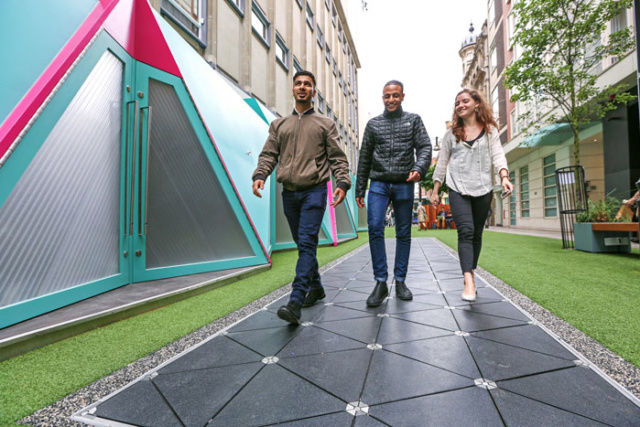
The New York Times journalist Thomas Friedman once asked, “Do you know what my favorite renewable fuel is? An ecosystem for innovation.” If you pose the same question to Pavegen founder and CEO Laurence Kemball-Cook, his answer would most likely be: foot traffic.
That’s because Kemball-Cook, who is passionate about climate change, believes “technology alone won’t make cities perform more efficiently. It’s about changing behaviors.” To that end, he spent time developing renewable energy solutions in built-up urban environments and ultimately landed on the idea of capturing ambient energy from people and footfall. After testing a series of prototypes, Kemball-Cook jumped in feet first and launched Pavegen, a company that harvests energy and data from foot traffic.
Building a complex technological product that operates reliably in all physical conditions isn’t easy, however. City streets are constantly undergoing challenges, from extreme temperature variations to a wide range of forces and impacts, Kemball-Cook explained. “Engineering this versatility into our system has been a big challenge, and it has been a highly iterative process to get to where our design is today,” he said.
How it works
At its core, Pavegen technology is a multi-functional, custom flooring system that transforms foot traffic into off-grid electricity. As pedestrians walk across the system, the weight from their steps creates a vertical movement in the top surface between 5 and 10 millimeters. Electromagnetic generators below the surface compress, creating a rotary motion which produces 2 to 4 joules of energy per step, or roughly 5 watts of continuous power which can be stored in batteries or deployed locally to power applications such as lighting, sensors, and data transmission.

Pavegen’s latest model, the V3, features a unique, triangular configuration that enables the tiles’ connected surface to move as a whole. As a result, Kemball-Cook says the formation enables a generator to be placed under each point of the tiles, which translates into greater energy converted per square foot than previous models—200 times more than initial prototypes, in fact. Further, the size of the triangles and the amount of resistance in the flywheels have been modeled using data on the length, speed, and force of human steps. “We use this information to maximize efficiency, and capture most of the available energy from footfall to produce a steady stream of off-grid energy and data.”
Additionally, the Pavegen system is able to connect to a range of mobile devices and building management systems. “As well as energy, our systems also provide data on energy output and can connect to users’ smartphones via low-power Bluetooth beacons,” Kemball-Cook said. “We have an app where people can see how much electrical energy they are generating and convert this into rewards, which also generates valuable relationship data.”
Ultimately, strengthening the relationship between people and the environment is what Pavegen is all about. “Our technology enables people to directly engage with clean energy, to increase their understanding of sustainability issues, and to generate useful off-grid energy,” he said. “Pavegen’s combination of physical interactivity and rich data is helping to bring smart cities to life. Forget the Internet of Things, we’re building the Internet of Beings.”
https://youtu.be/_sby4GR0sD8
